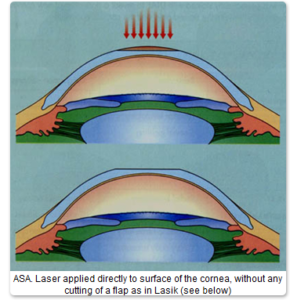 When patients read about laser vision correction they are presented with a multitude of names, acronyms, and abbreviations. Whether it’s LASIK, iLASIK, intraLASIK, PRK, LASEK, or epi-LASIK, it’s all extremely confusing even for the most enthusiastic patient who is about to undergo this life changing laser eye surgery. Is any technique really better than any other? How do doctors decide what to recommend, and how do you decide what to choose?
When patients read about laser vision correction they are presented with a multitude of names, acronyms, and abbreviations. Whether it’s LASIK, iLASIK, intraLASIK, PRK, LASEK, or epi-LASIK, it’s all extremely confusing even for the most enthusiastic patient who is about to undergo this life changing laser eye surgery. Is any technique really better than any other? How do doctors decide what to recommend, and how do you decide what to choose?
Laser eye surgery for vision correction works by reshaping the curvature of the transparent layer of the eye in front of the pupil, called the cornea. The laser evaporates corneal tissue elegantly and delicately, making it flatter in short sighted (myopic) people and steeper in the long sighted (hyperopic).
Overall there are really just two laser techniques, the difference being where on the cornea the laser is performed-either on the surface, or deeper under a thin flap of corneal tissue.
Surface Treatments (PRK)
The first technique which can be called “surface treatment” as the laser affects the surface of the cornea directly, involves the gentle removal of the outer skin-like layer of cells called the epithelium, exposing the tissue below which then receives the laser. After the treatment there is a period of about 5 days when the eyes are uncomfortable, tender and watery with blurry vision as the epithelium grows back and the eye surface heals. The original name of this technique is Photorefractive Keratectomy or PRK and is the longest established laser technique with over 20 years follow up, stable long term results and is extremely safe. Many people also refer to PRK as ASA (Advanced Surface Ablation)
Epi-Lasik and LASEK are almost the same as PRK except both remove the epithelium in such a way (the former mechanically with a blunt instrument which slides across the eye, the latter with dilute alcohol which chemically loosens the tissue) that it can be replaced again afterwards. Some claim that by replacing the epithelium, recovery is more comfortable and may give better visual results especially with high prescriptions. These claims are controversial and not universally accepted, as tests have shown that the original epithelium tends to dissolve and is in any case replaced by fresh epithelium growing in.
The safety and ultimate vision are the same for all surface techniques- excellent .


